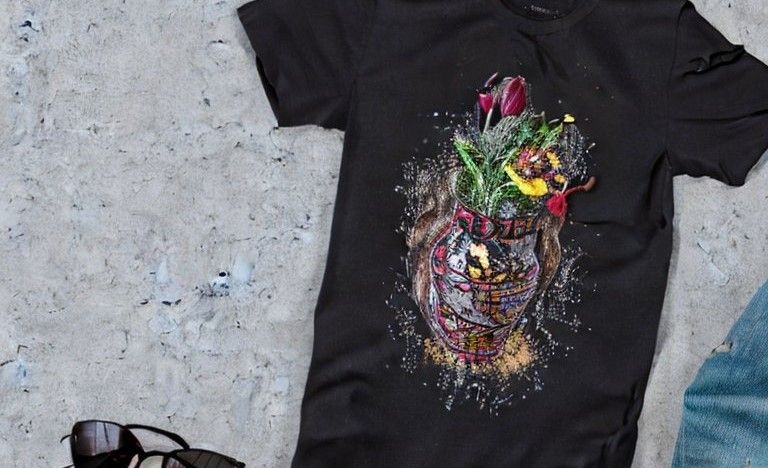Since the sublimation ink bonds to the fabric, direct sublimation on dark-colored t-shirts does not work well. The dye sublimation inks are there but are only visible on lighter garments and merchandise.
One option to put your sublimation design on a dark shirt is to use a base layer of HTV. This technique allows for more complex design elements and can create vivid images with more color than what would be achievable with just HTV alone.
Materials Required:
Here is the list of materials you will need to sublimate on a dark shirt:
1. Light-colored heat transfer vinyl
2. Sublimation printer
3. Dye sublimation ink
4. Vinyl cutter/Cricut machine or scissors
5. Heat resistant tape
6. Lint roller
7. Heat Press
8. Parchment paper or Teflon sheet
9. Shirt
Steps to Sublimate on Dark T-Shirts

Step 1: Create your design
There are plenty of design programs out there that can help you make whatever kind of design you have in mind like Adobe Illustrator or CorelDraw. It's easy to get creative and experiment with various art forms or pictures. You can also look for images on the web and modify them according to your liking instead.
Step 2: Cut the Vinyl
Vinyl cutting is an important step in creating any custom project, and the key to ensuring a high-quality look lies in how you cut the vinyl. Depending on the shape of the design, you can opt for a square or round cut, or get creative and cut out the actual design. For more intricate designs with several bits joining together, it's usually easier to go for the outline rather than making multiple cuts between pieces. When it comes to cutting vinyl, make sure you only choose heat transfer material in light colors - white is often best.
Step 3: Print The Design On The Sublimation Paper
To get the best results it is important to select the highest quality print option when printing your design on the sublimation paper. Also, ensure that you have mirrored the design before sending it to print, otherwise, you will end up with a design facing the wrong way.
Step 4: Cut the Sublimation Paper
Cutting out the excess parts of your designs on the sublimation paper is one of the most tedious steps of this technique, but also one of the most necessary. After printing it, you should let it dry for a couple of minutes before cutting it out with scissors. The cut does not need to be perfect, but you'll still need to accurately capture the outline and dimensions of the design while snipping away the unused portions of the paper. Not doing this could lead to ink being transferred outside its designated area on your garment or vinyl, which will affect the final quality of your project.
Step 5: Clean And Smooth The Shirt
To ensure the highest quality when pressing your heat transfer vinyl onto a shirt, the fabric must be free of any debris and as smooth as possible. To accomplish this, you can use a lint roller to remove any dirt or dust that may have gathered on the shirt. After that press or iron any wrinkles from the shirt. This simple step will help ensure that your final product comes out looking crisp and clean.
Step 6: Heat Press The Vinyl
Heat pressing the vinyl is the next step of the process. To guarantee the best result, make sure to follow the usual steps by aligning the design correctly and pre-press the fabric for 5 to 10 seconds. It’s also important to use appropriate materials – like parchment paper or Teflon sheet – when heat pressing vinyl. Use the recommended time, temperature, and pressure of the type of vinyl you’re using.
Step 7: Press the Sublimation Paper
After pressing your HTV piece, let it cool before heating your heat press and prepping to put the sublimation paper over it. It's important to make sure everything is properly aligned for good results, and using thermal tape can help prevent the paper from slipping during the application process. Finally, follow the heated material's guidelines for time and temperature; for most, that would be 190℃ for 50 seconds.
There you have it, the 7 steps for how to sublimate on dark shirts! Those are the steps to using a combination of sublimation and HTV to create unique eye-popping designs on dark shirts.
FAQ About Sublimation And Sublimation On Dark Fabrics
Q: What is sublimation printing?
Sublimation printing uses special ink in an inkjet printer that first prints the image on heat transfer paper and then transfers it to a substrate using a heat press. When the sublimation ink is heated it turns into a gas and then bonds with the material of the substrate. With shirts or other fabrics, this technique creates results that are vivid, long-lasting prints. Unlike other methods of shirt printing, sublimation printing will not crack or peel away over time due to its permanent bonding with the material.
Q: When using the above process can the dark fabrics be cotton?
The normal sublimation process requires at least 65% polyester since sublimation ink does not bond to natural material. With the process we outlined above you are using HTV as a base so you can use this process with cotton fabrics regardless if they are dark colors or light colors.
Q: How long do sublimation t-shirts last?
A: There are many variables, but the image on a sublimation print t-shirt should last as long as the shirt itself! With the process outlined in this article to transfer an image to dark garments, it is important to know that the final result will not last as long as a true sublimation shirt. This is because the HTV will be on top of the shirt, not bonded to the fibers of the shirt like normal sublimation printing.
Q: What t-shirts are the best for sublimation?
A: In general 100% polyester shirts are the best. Polyester / Cotton blends also work well for some applications as long as the shirt is at least 65% polyester. For more information see our article on the best shirts for sublimation.
Q: What Kind Of Ink Do I Use?
A: The sublimation ink that you use will be based on your printer. Printers Jack and Hiipoo are two of the most popular brands. Read our article for a full list of the best sublimation inks






Related Posts
The 6 Best Shirts for Your Sublimation Projects!
Jan 28, 2023
Best Sublimation Printer For T-Shirts
Jan 27, 2023
The Best Epson Printer For Sublimation
Jan 27, 2023